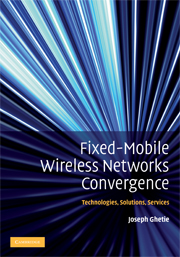Book contents
- Frontmatter
- Contents
- Disclaimer
- How the Book is Organized
- List of Figures
- List of Tables
- Preface
- Acknowledgments
- Acronyms
- Part I Wireless Communications: Networking and Management
- Part II Cellular Mobile Radio Networking and Management
- Part III Fixed Wireless Technologies: Networking and Management
- Part IV Fixed Wireless Cellular Mobile Networks Convergence and Integration
- Part V Fixed Wireless Cellular Mobile Networks Convergence: Standardized Networking Solutions
- 15 UMA-based Fixed Wireless and Cellular Mobile Networking Solutions and Products
- 16 Session Initiation Protocol
- 17 IMS-based Fixed Wireless and Cellular Mobile Networking Solutions and Products
- Part VI Fixed-Mobile Convergence Services, Industry Trends, and Implementation Issues
- References
- Index
15 - UMA-based Fixed Wireless and Cellular Mobile Networking Solutions and Products
from Part V - Fixed Wireless Cellular Mobile Networks Convergence: Standardized Networking Solutions
Published online by Cambridge University Press: 21 August 2009
- Frontmatter
- Contents
- Disclaimer
- How the Book is Organized
- List of Figures
- List of Tables
- Preface
- Acknowledgments
- Acronyms
- Part I Wireless Communications: Networking and Management
- Part II Cellular Mobile Radio Networking and Management
- Part III Fixed Wireless Technologies: Networking and Management
- Part IV Fixed Wireless Cellular Mobile Networks Convergence and Integration
- Part V Fixed Wireless Cellular Mobile Networks Convergence: Standardized Networking Solutions
- 15 UMA-based Fixed Wireless and Cellular Mobile Networking Solutions and Products
- 16 Session Initiation Protocol
- 17 IMS-based Fixed Wireless and Cellular Mobile Networking Solutions and Products
- Part VI Fixed-Mobile Convergence Services, Industry Trends, and Implementation Issues
- References
- Index
Summary
What is Unlicensed Mobile Access or GAN?
Unlicensed Mobile Access (UMA) is an architecture and a set of specifications that provides convergence of cell-based mobile radio GSM/CDMA networks with IP-based fixed wireless access networks. Examples of fixed wireless networks include IEEE 802.11 a/b/g WLANs, IEEE 802.16 WMANs (WiMAX), IEEE 802.20 Ultra Wideband, IEEE 802.15.1 Bluetooth WPANs, and Near-Field Sensor Networks. UMA subscribers are provided with total location, mobility, and service transparency.
UMA development was initiated in January 2004 by a group of mobile service infrastructure providers and mobile handset manufacturers: Alcatel, AT&T Wireless, British Telecom, Cingular, Ericsson AB, Kineto Wireless, Motorola, Nokia, Nortel Networks, O2, Roger Wireless, Siemens AG, Sony Ericsson, and T-Mobile. By mid 2005, key components of the UMA specifications, dealing with user, architecture, protocols, and conformance testing aspects were developed. These specifications were submitted to the 3G Partnership Project (3GPP), as part of a work item called “Generic Access to A/Gb Interfaces”. Since then, these specifications, also known as TS 43.318, have been approved and incorporated in 3GPP Release 6 documentation. Consequently, the UMA initiators have decided to disband the independent working group and to continue their effort under the umbrella of the 3GPP organization. Since its adoption by the 3GPP, the UMA name has been changed to Generic Access Network (GAN). However, the old name is still used in technical and marketing circles, so for this reason, we will continue to use it in this book.
- Type
- Chapter
- Information
- Fixed-Mobile Wireless Networks ConvergenceTechnologies, Solutions, Services, pp. 289 - 302Publisher: Cambridge University PressPrint publication year: 2008



